Insurance
-
- Understanding the Ups and Downs of Insurance Maritime Reporter, Apr 2013 #22
Business is cyclical, and nowhere is there more evidence of its cyclical nature than in the insurance market, characterized by ups and downs in insurance premiums, coverages and profitability.
By most accounts, the current insurance market has been one of the most competitive in recent memory. With intense price-cutting and expanding coverages, these conditions are typical of a “soft” market which is very much a buyers’ market. The obvious benefits of a ‘soft’ market to the buyer are lower insurance premiums, broader coverage, easier underwriting criteria, larger policy limits and more insurance carriers looking to gain their business.
The reality, however, is that insurance companies cannot sustain themselves in market conditions like these for any period of time without significant financial consequences. When natural catastrophes like Superstorm Sandy or events like Deepwater Horizon or the Costa Concordia occur, the value of insurance becomes very apparent. Many companies would be faced with financial ruin were it not for their ability to collect a good part of their financial losses from various insurance coverages. Paying losses is what insurance companies do and to be able to pay expected losses along with catastrophic losses, companies need to have a capital base or surplus set aside so they can respond when the worst happens. Collecting inadequate premiums and incurring higher than expected losses will eventually deplete the balance sheets of even the strongest companies. Insurers eventually need to replenish their capital and build a cushion to position themselves to be able to respond to claims, be they attritional or catastrophic.
Large Losses
One of the worst years ever for the insurance industry was 2011. According to the Insurance Information Institute in New York, in 2011, catastrophes worldwide caused an estimated $350 billion in economic losses, shattering the previous record of $230 billion set in 2005, the year of Hurricanes Katrina, Wilma and Rita. High catastrophe losses, along with high underwriting losses in key non-catastrophe exposed lines such as workers compensation, helped push the industry’s combined ratio to 108.2—its highest level since 2001. Generally speaking, insurers gauge their underwriting success and stability on their combined ratio which is simply losses and expenses divided by premiums. If the combined ratio is under 100% a company is said to have an underwriting profit. High combined ratios are a sign of poor financial health and when an insurance company consistently runs a high combined ratio they will eventually become financially impaired and might not have the money to pay its claims leaving policyholders left holding the bag.
As part of the underwriting process, projected losses on individual accounts are developed by underwriters when evaluating a new account or renewing an existing one. This process is imprecise at best and highlights the fact that insurance companies sell a product, the cost of which they do not know at the time of sale. This creates one of the greatest challenges for any insurance company: to set the proper level of loss reserves. Incurred and reported losses must be reserved at realistic levels reflecting the true potential payouts plus expenses associated with adjusting claims. In addition, for those lines of business with so called long tail exposures like certain classes of liability insurance, setting a reserve for future losses that will occur as a result of writing these polices takes the considerable skills of highly experienced actuaries. Most insurance company failures have been the result of inadequate loss reserving.
Underwriting is only half the equation for insurance companies. Investment returns are another factor affecting where the insurance market is in its cycle. Insurance companies collect premium for taking risks which in turn, is invested to generate cash for investment at a lower cost than other sources of capital. In the past, when interest rates were higher, the insurance industry relied on investment income from not only premiums but from loss reserves and surplus to generate additional income. Today, with record low interest rates returns on their investments cannot make up the shortfall if underwriting income falters. To alleviate dependence of investment returns, in a weakened investment economy, insurers must take a more disciplined approach to their underwriting. This could mean passing on business that an insurer may have written in a soft market. Or, it could mean adjusting rates to more adequately reflect the risk it is assuming.
Insuring Insurers
One of the functions of insurance is to spread risk and reinsurance is insurance that insurers purchase to improve their spread of risk and to otherwise protect their business. Buying reinsurance is an expense just like the purchase of insurance and when an insurer suffers a multi-million loss, a portion of the loss is likely covered by reinsurance. As a result of recent loss events, reinsurers have paid out significant amounts of money and reinsurance rates are now rising. Like marine, property or casualty underwriters, reinsurance underwriters also take a closer look or restrict what risks they will reinsure. In part, a rise in reinsurance rates is often a precursor to insurance rate increases and stricter underwriting discipline.
So, losses occur. Investment results are low. And insurers’ reinsurance rates creep up. These are the first signs that the insurance market might be heading the other way into a so called “hardening” market. Under these conditions, insurers reevaluate the risks they underwrite, the rates they will charge and the coverages they will provide. They look to tightened insurance coverage terms and conditions, including available capacity. As marine insurance is considered to be the oldest form of insurance, the market has seen and survived its share of market cycles.
While most early marine insurance came from Lloyd’s of London, a few American marine insurers formed during the War of 1812. When the fighting ended, price wars broke out between American and British insurers.
By the Civil War, many American marine insurers were out of business but those who survived were stronger and some are still in business today.
Surviving Cycles
The history of marine insurance is filled with stories of companies who survived and others who didn’t. And in today’s dynamic business environment, the challenges are greater than ever. Survival in today’s insurance market depends on many factors but disciplined underwriting and investing are paramount. Those companies who are disciplined and have the best talent and expertise in the lines of business in which they choose to be active participants will persevere and thrive. While market conditions impact transactional business, many buyers know that the best deal is not always the cheapest one. Having established broker and insurance carrier relationships often outweighs excessive premium savings. Working relationships become particularly important as market conditions begin to turn and buyers, especially those businesses with complex risks such as the marine industry, may have more difficulty buying insurance with the terms and conditions they want. Long term relationships and working with experienced underwriters and brokers might not always be the least expensive approach to the purchase of insurance but working with insurance professionals who have the knowledge and understanding of an insured’s business and can provide additional services in the form of risk control and professional claims expertise will more often than not get a buyer of insurance the “best” deal.
More disciplined underwriting requires insurers will be asking more questions to understand the risk they will be taking on when issuing or renewing a policy. Therefore, in this business climate, insurance buyers are wise to prepare ahead when renewing their insurance. Companies need to plan in advance and get the renewal specifications together early. Insurers are examining their risk retentions and rates as they review renewals and some companies may be willing to accept more risk retention, or in other words, higher deductibles, to get better overall rates. And, in a weakened economy, underwriters will look carefully to see how a business’ exposures might be changing as a result of the economy. At times, it is a test of willpower. In a ‘hard’ market, insurers do not want business at any cost, but at the right cost. And, adhering to strict disciplined underwriting is a matter of survival to service their customers now and years from now.
Buying insurance is an important financial decision for any company. And in most cases, businesses want their insurance companies to be with them for the long haul. Insurance companies sell their promise to serve and offer financial support to their clients in the event of a loss. It’s an agreement to pay a claim. In order to do that, they need quality underwriting results that produce a profit to contribute to the financial strength that allows an insurance carrier to remain true to its claims-paying promise.(As published in the April 2013 edition of Maritime Reporter & Engineering News - www.marinelink.com)
-
- Inland Marine Insurance: Assuring Property and Goods Move Forward Marine News, Sep 2017 #26
that manufacture and ship product still have a lot of ground to cover getting their various goods to their final destinations. The ocean marine insurance market, the oldest insurance market in the world, was initially developed to protect these goods while crossing the ocean’s open waters, later to
-
- The Complicated Business of Marine Construction Worker Claims Marine News, Oct 2017 #16
The right insurance policy could help you stay above water after a workplace incident. The day-to-day job of marine construction workers has many potential hazards. While restoring shorelines, dredging harbors, repairing bridges and building docks, they often operate heavy machinery. Manning cranes
-
- Navigating 2016’s Marine Insurance Market Maritime Logistics Professional, Q1 2016 #19
Marine insurance may have the distinction of being the oldest line of insurance in existence, but it’s not letting its venerable age hinder its growth or flexibility. Given the new, emerging and increasingly complex risks faced by the maritime industry, the insurance market must adapt to meet the evolving
-
- When is a Ship Not a Ship? Maritime Logistics Professional, Q4 2013 #18
Does your insurance coverage fit your operation? No business likes to hear the word “denied” from their insurance company. But when a business purchases an insurance policy, it enters into a contract that carefully outlines what insurance protection is being offered to the business, and what is not. To
-
- How to Work with Your Insurer When Experiencing a Loss Maritime Reporter, Apr 2014 #24
Marine insurance – just like health, automobile and homeowner’s insurance – can be a valuable safeguard in case something unexpected happens. And when something bad happens, it provides reassurance that you have assistance in place to help get back to business quickly. In the maritime industry, there is a
-
- Transferring Risk for Long-term Success Maritime Reporter, Feb 2014 #18
to long-term success is making sure that risk is managed properly, either by transferring it to others or covering it with the right type and amount of insurance. It is important to understand both the opportunities and the pitfalls of transferring risk so you do not inadvertently end up with significant exposure
-
- The Cause behind the Clause Piers & Docks Insurance Maritime Reporter, Jul 2014 #18
business owner, your day-to-day focus is on managing and growing your business. Understandably, thinking about and understanding the nuances of your insurance coverage is not likely to be among your top priorities. However, what if the unthinkable happens and your docks and piers are seriously damaged?
-
- Maritime & Offshore Employment: Contractors, Coverage and Confusion Maritime Logistics Professional, Q4 2014 #50
defines the risks in hiring contract workers in today’s marine and offshore markets, and lays out the course to mitigating those headaches. Recruitment, insurance and peace of mind – all rolled into one neat package. Misclassifying Contract Workers Leads to Insurance Confusion It’s no secret that the marine
-
- How to Approach Maritime Cyber Security Maritime Reporter, Mar 2015 #66
approach to risk management. Cyber security posture continues to develop as a critical component of a maritime security strategy, and cyber security insurance has become a valuable layer of protection that risk managers must consider. While the insurance industry has decades or more of actuarial data
-
- Logistics and Warehouse Insurance: Understanding its Complexity Maritime Reporter, Apr 2015 #28
. Unfortunately, the fire was determined to be a result of poor maintenance practices at the terminal. All of the parties involved relied on their insurance policies to reimburse them for the loss. The question is did they have the right coverage. Were the goods in long term storage? Were the goods
-
- MN 100: Gencorp Insurance Group Marine News, Aug 2015 #18
The Company: Gencorp Insurance Group provides the Insurance and Surety needs of Marine Contractors, Vessel Operators and Shipyards throughout the country and Caribbean. Gencorp’s Marine Group facilitates the coverage placement and claims settlement for all insureds, utilizing a team that has a Maritime
-
 )
April 2024 - Maritime Reporter and Engineering News page: 41
)
April 2024 - Maritime Reporter and Engineering News page: 41have Machine Vision shipowners, and we are also seeing in- for responding to challenging situations. Groke Pro is the ? rst machine vision terest from insurance companies. In Groke Pro was not designed to re- solution to obtain Innovation Endorse- high-risk situations, a recording of im- place crew on board
-
 )
April 2024 - Maritime Reporter and Engineering News page: 15
)
April 2024 - Maritime Reporter and Engineering News page: 15a judicious selection of approaches and treatment a return on The Author investment can be realized. Inspection of the treatment installations is the “insurance” Fischer required to ensure that all the effort going into a quiet ves- Raymond Fischer (pictured) and Leonid Boroditsky have been involved with
-
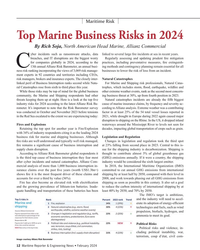 )
February 2024 - Maritime Reporter and Engineering News page: 12
)
February 2024 - Maritime Reporter and Engineering News page: 12manage- businesses to lower the risk of loss from an incident. ment experts in 92 countries and territories including CEOs, risk managers, brokers and insurance experts. The closely inter- Natural Catastrophes linked peril of Business Interruption ranks second while Natu- For Marine and Shipping risk professionals
-
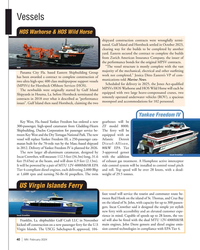 )
February 2024 - Marine News page: 40
)
February 2024 - Marine News page: 40in October 2023, clearing way for the builds to be completed by another yard. Eastern secured the contract to complete the builds from Zurich American Insurance Company, the issuer of the performance bonds for the original MPSV contracts. “The vessel structure is mostly complete with the vast HOS Panama
-
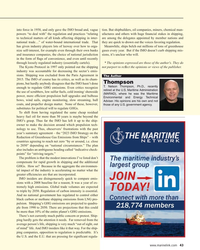 )
December 2023 - Maritime Reporter and Engineering News page: 43
)
December 2023 - Maritime Reporter and Engineering News page: 43of tons of greenhouse nize self-interest, for example even through their own banks gases every year. But if the IMO doesn’t curb shipping mis- and insurance companies, the choice of national jurisdiction sions, it’s unclear who will. in the form of ? ags of convenience, and even until recently through
-
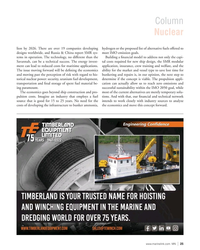 )
November 2023 - Marine News page: 25
)
November 2023 - Marine News page: 25. The energy invest- tal costs required for new ship design, the SMR modular ment can lead to reduced costs for maritime applications. application, insurance, crew training and welfare, and the The issue moving forward will be de? ning the economics ability for the market and vessel type to save lost
-
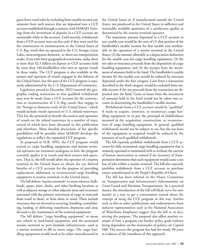 )
November 2023 - Marine News page: 19
)
November 2023 - Marine News page: 19, today there for the taxable year for cargo handling equipment, (3) the is more than $2.5 billion on deposit in CCF accounts held net sales or insurance proceeds from the disposition of cargo by more than 140 fundholders who own or operate vessels handling equipment, and (4) the receipts from the
-
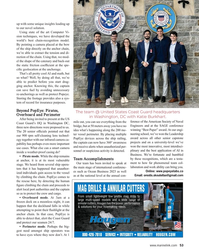 )
September 2023 - Maritime Reporter and Engineering News page: 53
)
September 2023 - Maritime Reporter and Engineering News page: 53, the captain can save fuel by avoiding unnecessary re-anchorings as well as protect Popeye. Storing the footage provides also a sys- tem of record for insurance purposes. Beyond PopEye: Pirates, The team @ United States Coast Guard headquarters Overboard and Perimeter in Washington, DC with Katie Burkhart
-
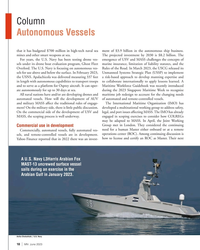 )
June 2023 - Marine News page: 18
)
June 2023 - Marine News page: 18. Navy has been testing drone ves- emergence of USV and MASS challenges the concepts of sels under its drone boat evaluation program, Ghost Fleet marine insurance, limitation of liability statutes, and the Overlord. The U.S. Navy is focusing on autonomous ves- Rules of the Road. In March 2023, the USCG released
-
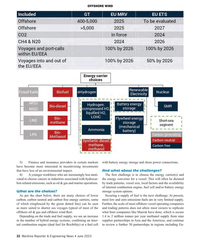 )
June 2023 - Maritime Reporter and Engineering News page: 32
)
June 2023 - Maritime Reporter and Engineering News page: 32OFFSHORE WIND 3) Finance and insurance providers in certain markets with battery energy storage and shore power connections. have become more interested in incentivizing investments that have less of an environmental impact. And what about the challenges? 4) A younger workforce who are increasingly less
-
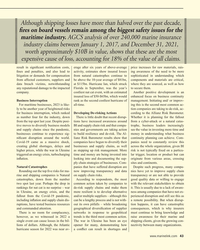 )
February 2023 - Maritime Reporter and Engineering News page: 43
)
February 2023 - Maritime Reporter and Engineering News page: 43over the past decade, f res on board vessels remain among the biggest safety issues for the maritime industry. AGCS analysis of over 240,000 marine insurance industry claims between January 1, 2017, and December 31, 2021, worth approximately $10B in value, shows that these are the most expensive cause
-
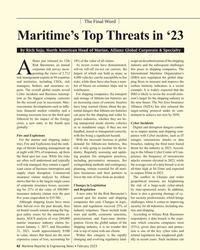 )
February 2023 - Maritime Reporter and Engineering News page: 42
)
February 2023 - Maritime Reporter and Engineering News page: 42ship- and territories, including CEOs, risk risks, while there have also been a num- ping ? eets to measure and improve the managers, brokers and insurance ex- ber of blazes on container ships and in carbon intensity indicators is a recent perts. The overall global results reveal warehouses. example
-
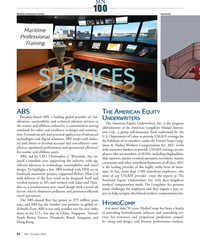 )
October 2022 - Marine News page: 54
)
October 2022 - Marine News page: 54to setting administrator of the American Longshore Mutual Associa- standards for safety and excellence in design and construc- tion Ltd., a group self-insurance fund authorized by the tion. Focused on safe and practical application of advanced U.S. Department of Labor to provide USL&H coverage for technologies
-
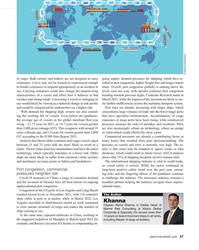 )
September 2022 - Maritime Reporter and Engineering News page: 27
)
September 2022 - Maritime Reporter and Engineering News page: 27effects of the pandemic continue pressures heighten risk Covid-19 measures in China, a surge in consumer demand to challenge the industry. The insurance industry remains a and the invasion of Ukraine have all been factors in ongoing steadfast partner helping the industry navigate these unprec- unpreceden
-
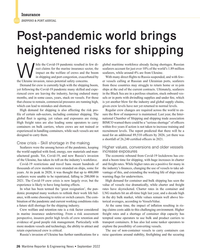 )
September 2022 - Maritime Reporter and Engineering News page: 26
)
September 2022 - Maritime Reporter and Engineering News page: 26Insurance 2022 SHIPPING & PORT ANNUAL Post-pandemic world brings heightened risks for shipping hile the Covid-19 pandemic resulted in few di- global maritime workforce already facing shortages. Russian rect claims for the marine insurance sector, the seafarers account for just over 10% of the world’s 1.
-
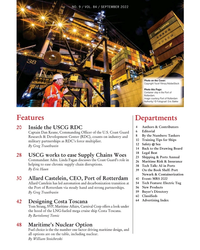 )
September 2022 - Maritime Reporter and Engineering News page: 2
)
September 2022 - Maritime Reporter and Engineering News page: 2USCG works to ease Supply Chains Woes 23 Shipping & Ports Annual Commandant Adm. Linda Fagan discusses the Coast Guard’s role in 26 Maritime Risk & Insurance helping to ease chronic supply chain disruptions. 38 Tech Talk: AI in Ports By Eric Haun 39 On the Book Shelf: Port Newark & Containerization 40
-
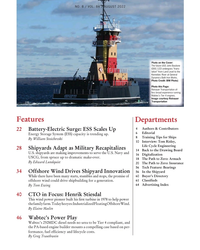 )
August 2022 - Maritime Reporter and Engineering News page: 2
)
August 2022 - Maritime Reporter and Engineering News page: 2the U.S. Navy and 16 Digitalization USCG, from spruce up to dramatic make-over. 18 The Path to Zero: Armach By Edward Lundquist 20 The Path to Zero: Insurance 56 Tech Feature: Bearings 56 In the Shipyard 34 Offshore Wind Drives Shipyard Innovation 60 Buyer’s Directory While there have been many starts
-
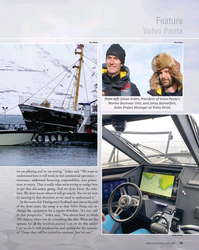 )
July 2022 - Marine News page: 24
)
July 2022 - Marine News page: 24Project Manager at Volvo Penta we are piloting and we are testing,” Inden said. “We want to understand how it will work in real commercial operation— insurance, additional ? nancing, responsibility, data protec- tion, et cetera. That is really what we’re trying to nudge here to get that discussion going
-
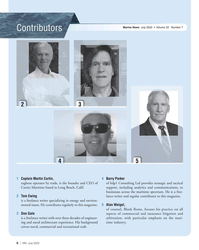 )
July 2022 - Marine News page: 5
)
July 2022 - Marine News page: 5regularly to this magazine. 5 Alan Weigel, of counsel, Blank Rome, focuses his practice on all 3 Don Gale aspects of commercial and insurance litigation and is a freelance writer with over three decades of engineer- arbitration, with particular emphasis on the mari- ing and naval architecture
-
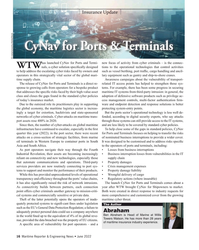 )
June 2022 - Maritime Reporter and Engineering News page: 16
)
June 2022 - Maritime Reporter and Engineering News page: 16Insurance Update CyNav for Ports & Terminals © metamorworks/AdobeStock has launched CyNav for Ports and Termi- new focus of activity from cyber criminals – is the connec- WTW nals, a cyber solution speci? cally designed tions to the operational technologies that control activities to help address the
-
 )
June 2022 - Maritime Reporter and Engineering News page: 15
)
June 2022 - Maritime Reporter and Engineering News page: 15to 1,000 teu or more of undeclared dangerous cargo on board a 24,000 teu ultra-large container vessel. In 2019, the International Union of Marine Insurance (IUMI) and other stakeholders co-sponsored a submission to the International Maritime Organization (IMO) Sub Com- mittee on Carriage of Cargoes
-
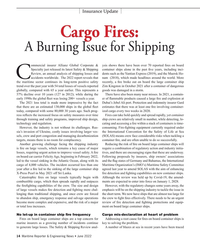 )
June 2022 - Maritime Reporter and Engineering News page: 14
)
June 2022 - Maritime Reporter and Engineering News page: 14Insurance Update Cargo Fires: A Burning Issue for Shipping ommercial insurer Allianz Global Corporate & ysis shows there have been over 70 reported ? res on board Specialty just released its latest Safety & Shipping container ships alone in the past ? ve years, including inci- Review, an annual
-
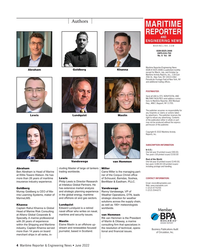 )
June 2022 - Maritime Reporter and Engineering News page: 4
)
June 2022 - Maritime Reporter and Engineering News page: 4Willis Towers Watson. He has ner of the Corpus Christi of? ce CONTACT INFORMATION: more than 28 years of maritime Lewis of Schouest, Bamdas, Soshea, insurance industry experience. Philip Lewis is Director Research BenMaier & Eastham, PLLC. Email: [email protected] at Intelatus Global Partners. He
-
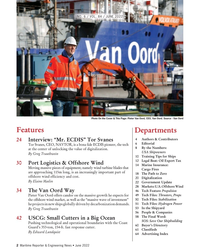 )
June 2022 - Maritime Reporter and Engineering News page: 2
)
June 2022 - Maritime Reporter and Engineering News page: 2. USA Shipowners By Greg Trauthwein 10 Training Tips for Ships 12 Legal Beat: Oil Export Tax 30 Port Logistics & Offshore Wind 14 Marine Insurance: Moving massive pieces of equipment; namely wind turbine blades that Cargo Fires are approaching 115m long, is an increasingly important part
